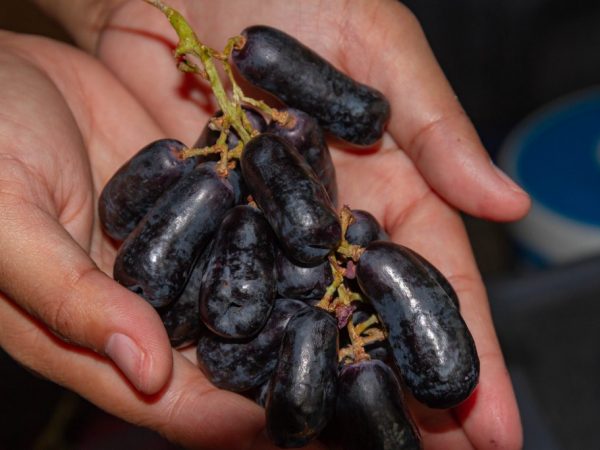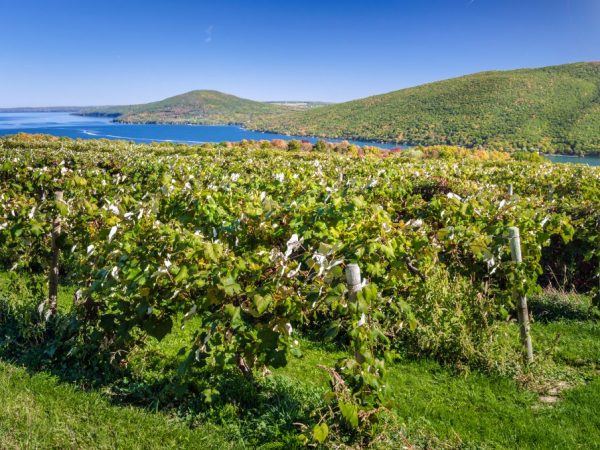Velika grape variety
The Velika grape variety is one of the most demanded. The berry is a cross product, it has an unusual size. This is what the Velika Grape attracts attention with.

Velika grape variety
Characteristic
The Velika grape variety is in demand due to its extreme fertility and the fact that the leaves acquire a fiery hue in autumn, thereby ennobling the garden.
The decorativeness of the plant does not prevent it from tying fruits that are much larger than those of other species. It does not tolerate cold weather, but the damaged bush after frost does not die completely, it is restored with proper care. The species is self-fertile, it does not need to be planted with another berry variety for pollination.
Description of the bush
According to the description, the bush is tall and will grow quickly. Because of this, gardeners are engaged in the formation of bushes already 3 months after planting in open ground. During flowering, the vine forms bisexual flowers, so that complete pollination occurs. Leaves are small in size, some are colored brown. The stem is medium.
Description of fruits
The description of the fruit of the Velika grape variety differs from that characteristic of other species of this plant. The berries are oblong, conical, weighing up to 14 g. The bunch weighs from 600 to 900 g. The color of the fruit is dark, mostly purple, sometimes with a red tint. The pulp tastes like ripe cherries, not too sweet, but also does not have a cloying aftertaste.
Growing grapes
The best period for cultivating the variety is autumn: at this time, the survival rate of grapes is especially high.
Growing berries begins with a seedling, some gardeners choose to work with cuttings, but with them it is much more difficult. After planting the seedling in the ground, a bush is formed, since this species is fast-growing. Further, the growing process includes:
- top dressing;
- temperature regime;
- watering mode;
- treatment and prevention of diseases.
Landing in the soil
A few weeks before planting, the soil is fed with mineral fertilizer. Next, they choose a landing site. It should be well lit by the sun, even, without drafts.
In the selected area, holes are dug about 0.5 m deep, the soil from the holes is mixed with fertilizers. Gravel is spread on the bottom in a thin layer, a layer of planks or branches is applied on top. After treating the root system with a clay solution, the bush is planted in prepared holes. After the sprout is planted, it is watered with warm water and mulched with humus.
Plant care

It is important for a plant to be in the sun.
According to the description, a special design is used to form healthy bushes. As it grows, the bush is tied to 2 metal posts, thereby forming the direction they need.
The culture is thermophilic; in winter frosts, the bushes need shelter. The insulation is removed after the sudden changes in temperature cease. In early spring, the bush is not yet opened.The plant needs a lot of sunlight: if the bush is planted in the shade, it will bear little fruit.
Watering
At the beginning of planting sprouts, the watering regime is observed with caution. Since an excess of moisture will lead to rotting of the root system. A lack of moisture will lead to drying out of the soil. For about a month, watering is carried out every day, until the shoots take root, over time it is reduced to once a week. From 4 years after planting in open ground, the plant is watered 3-4 times a season.
Fertilizer
Top dressing is carried out in the spring. Before opening after winter frosts, the culture is fed with superphosphates and potassium salt, the same feeding is necessary before flowering.
Every 3 years in the fall, plantings are fertilized with manure. Also, after harvesting, potash fertilizers are applied. The soil periodically needs mineral fertilizers and nitrogen fertilization.
Diseases and pests
Lack of nutrition, excess moisture, or, conversely, dry soil lead to diseases of the grapes. The bush is attacked by bacterial and viral diseases, as well as fungus and rot.
There are many pests that affect the plant and lead to the absence of fruit ovary. You can notice that there is something wrong with the grapes by looking at the leaves of the bush. When damaged, spots, black dots, holes appear on them.
Fight disease
After the detection of diseases, the bush is treated with special chemicals for about a month. All damaged areas are removed.
The following drugs are used in the fight against diseases:
- Oxyhom;
- Abiga Peak;
- Tiovit Jet;
- Bordeaux liquid.
Having completely processed all the bushes and nearby plants with these means, gardeners save their plant.
Pest control
To combat pests, the plant is tied up just above the ground, sprayed with acaricides and all damaged areas are removed.
Prophylaxis
For the prevention of diseases, the culture is periodically sprayed with chemicals, fertilized the soil, and nourished the root system. The best prevention is timely inspection of the bushes and adherence to the rules of plant care.
Conclusion
The Velika grape is attractive for its high fruiting rates. The berries grow large and juicy. Crop care is required the same as for any other species of this culture.


